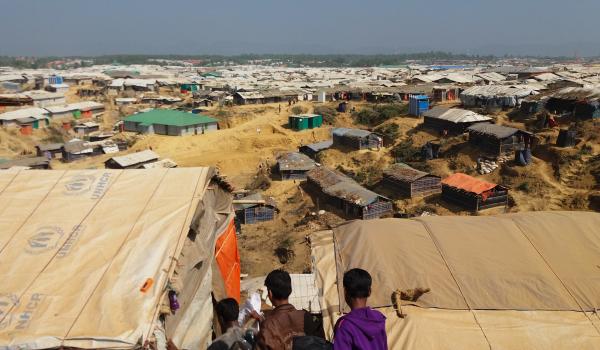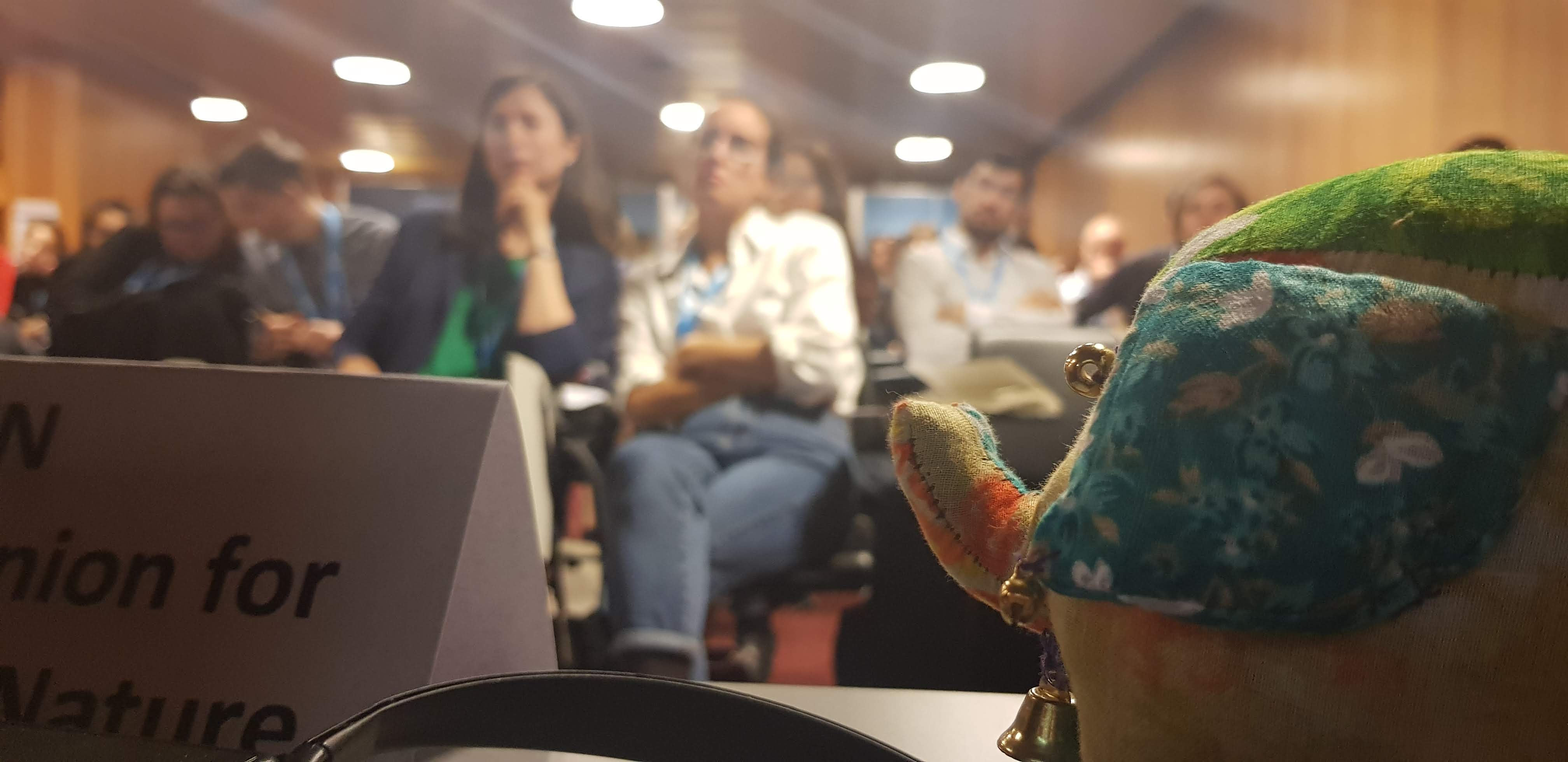No longer lost in translation – humanitarian and environmental sectors partner for Nature-based Solutions
The world needs further partnership between the humanitarian and environmental actors. This Wednesday, participants of the UN’s Humanitarian Network and Partnerships Week heard how elephants started the journey of UNHCR and IUCN working together towards a vision of green legacies for refugee settlements.

Photo: © IUCN/Haseeb Md. Irfanullah
The one slide that Raquib Amin put up for his talk was that of an elephant structure carried by Rohingya people. The frame had been made by the men of the camp, the colourful cloth covering by the women in a strategy to highlight the role of both genders in addressing the threat, and later opportunity, that five herds of elephants posed to their people. He then told the story of the endangered elephants trapped by the world’s largest refugee camp.
This elephant tells the story of our partnership.
– Raquib Amin (Country Representative, IUCN Bangladesh Office)
 Rohingya people training on how to handle the risk posed by wild elephants. The elephant structures were crafted by Rohingya,
Photo: IUCN
Rohingya people training on how to handle the risk posed by wild elephants. The elephant structures were crafted by Rohingya,
Photo: IUCN
In 2017 in Bangladesh, more than 600,000 Rohingya people crossed the border from Myanmar into Cox’s Bazar. Where they came to seek sanctuary, happened to be right on top of the vital elephant migration corridor. Tragedy followed. People who had fled their homes, were faced with an entirely new threat and 13 people lost their lives between September 2017 and February 2018. This tragedy catalysed the partnership of UNHCR and IUCN out of a need to protect people. The Rohingya have learned to live with their elephant neighbours, healing the environmental wounds of war, and the partnership has grown to work on other environmental issues in the camp such as greening the camps through reforestation and preventing land degradation. “In the future, partnerships should be created by design in advance, not by need after the fact,” said Raquib.
 The “Nature-based Solutions for Enhanced Humanitarian Action” side-event took place in a packed out room at the Humanitarian Network and Partnerships Week. The speakers, Pascale Meige (IFRC), Radhika Murti (IUCN), Karen Sudmeier-Rieux (UNDRR) and Raquib Amin (IUCN Bangladesh), shared the panel table with elephants crafted by Rohingya women as part of UNHCR and IUCNs work in Cox’s Bazar.
Photo: Daisy Hessenberger (IUCN)
The “Nature-based Solutions for Enhanced Humanitarian Action” side-event took place in a packed out room at the Humanitarian Network and Partnerships Week. The speakers, Pascale Meige (IFRC), Radhika Murti (IUCN), Karen Sudmeier-Rieux (UNDRR) and Raquib Amin (IUCN Bangladesh), shared the panel table with elephants crafted by Rohingya women as part of UNHCR and IUCNs work in Cox’s Bazar.
Photo: Daisy Hessenberger (IUCN)
This week, in Switzerland, humanitarian and environmental actors from gathered at the Humanitarian Network and Partnerships Week to discuss just that. In the next one and half hours, in the first UNHCR-IUCN event of its kind, these two sectors came together to hear how we can and are addressing the challenges that humanitarian action faces, for the future of people and planet alike. In this blog, we share the messages of hope and the solutions we found in room full of 60 people from around the globe.
Right away, the urgency was clear. The challenges our world faces, from food and water security to the climate emergency and disaster risks, are exacerbated in a humanitarian context. And human-nature interactions (and therefore conflicts) are predicted to expand in the context of refugees as 50 million more people become refugees in the coming decades, especially in Africa, Asia and the Pacific. It is becoming yet another significant global footprint on this planet; to ensure this footprint is a green one, leaving behind a sustainable legacy for all, international organisations and ministries need to seek out non-traditional partners and work together.
What was also clear was the demand to work together. While in previous Humanitarian Networks and Partnership Weeks, humanitarians struggled to address the environmental aspect of their work, saying “it’s nice but it’s not crucial”, the atmosphere was altogether a different one this February. In a packed out room, made up mostly of humanitarian experts wanting to work with the environmental sector (live survey), instead the emphasis was on the demand for partnerships and clarity on Nature-based Solutions. When the audience was surveyed for solutions to common humanitarian challenges, common themes included community engagement, risk management, and conservation actions, all of which are captured in a Nature-based Solutions approach.
Daisy Hessenberger (Junior Professional, IUCN Nature-based Solutions Group) opened the interactive diagnostic with technical notes on the definition of Nature-based solutions and the differences between nature-derived, nature-inspired and nature-based solutions.
Nature-based Solutions are Actions to protect, manage and restore natural or modified ecosystems, which address societal challenges, effectively and adaptively, providing human well-being and biodiversity benefits. – IUCN resolution (WCC-2016-Res-069-EN)
In reality, there are still some barriers. Radhika Murti (Director, IUCN Global Ecosystem Management Programme) commented “Humanitarians tend to work to address immediate crises. Conservationists tend to imagine five or ten year programs. We all often speak a different language.” Meanwhile Pascale Meige (Director of the Disaster and Crisis Prevention, Response and Recovery, IFRC) made a clear request - "We need the do's and dont's for volunteers on the ground.”
We do already have some tools available for translating between these two sectors. For example with the development of the IUCN Global Standard for Nature-based Solutions will do just that, providing a facilitative framework and common understanding to enable the design, verification and scaling up of Nature-based Solutions. Karen Sudmeier-Rieux (Senior Advisor, UNEP) presented the post-disaster and opportunity mapping tools already available to the community, highlighting that a network for collaborations of non-traditional partners exists. Partnership for Environment and Disaster Risk Reduction (PEDRR) is a global alliance of UN agencies, NGOs and specialist institutes.
To scale up the lessons learnt from the UNHCR-IUCN partnership in Bangladesh, started by those elephants in 2018, these two international organisations put in place a global memorandum of understanding in 2019. Since their memorandum of understanding last October, UNHCR and IUCN have continued to work together in Bangladesh, working with communities to protect both people and elephants, and developing concepts for green masterplans in humanitarian contexts. In their Project Hope video, these two international organisations called for increased investment to create green legacies for refugee settlements worldwide.
Partnerships for Nature-based Solutions need not start with tragedy and elephants. They can be as simple as starting conversations within and outside of your organisation, joining the PEDRR network, sharing lessons learnt on social media or directly contacting some non-traditional partners.
For more information on Nature-based Solutions and the IUCN Global Standard, please email NbSstandard@iucn.org
